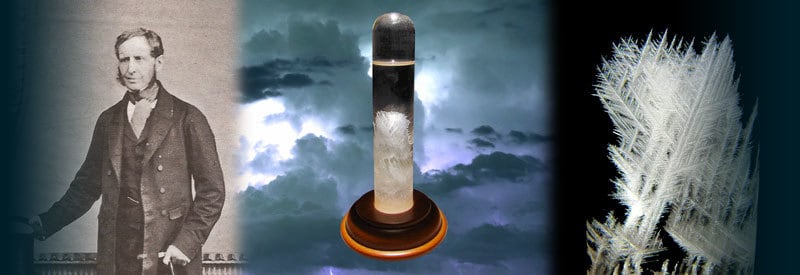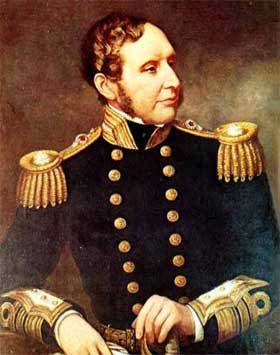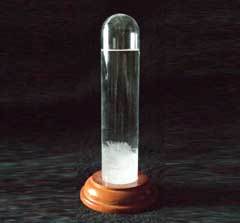The Storm Glass – What It Is And How It Was Used To Forecast The Weather

A few weather enthusiasts may have heard of a meteorological instrument called a storm glass, also known as a weather globe. We examine this device, how it works, and where it originated from.
A storm glass is defined as a meteorological instrument primarily used during the 19th century to predict the weather. It consists of a sealed glass tube filled with chemicals dissolved in distilled water. Predictions were based on the amount of crystallization and fogginess occurring in the liquid.
They may have different names but are all one and the same thing. They come in a variety of shapes and sizes. Many also come with different colored liquids, as they are mostly used for ornamental purposes nowadays.
A little more than a century ago, these instruments were considered serious meteorological devices that were widely used to predict the weather. It became especially popular in Britain during the mid-1800s. (More on its history a little later in this article.)
A Short History Of The Storm Glass
For some reason, the real inventor of the storm glass is unknown. What we do know, however, is that a British naval officer by the name of Admiral Robert FitzRoy is the man responsible for making it famous.

Admiral FitzRoy was a keen weather enthusiast, and during his time aboard the HMS Beagle, he did numerous experiments with the storm glass and carefully documented all his findings.
As a strong believer in the capabilities of the storm glass, Admiral FitzRoy promoted its use throughout the United Kingdom to help meteorologists make better weather forecasts, especially after a storm in 1859 caused hundreds of fatalities at sea.
Since the more accurate barometers of the time were too expensive for mass production, the British Crown ordered large numbers of storm glasses to be delivered to coastal towns and maritime communities throughout the British Islands.
At the time, storm glasses became commonly known as "FitzRoy's storm barometers."
During the late 1800s, mercury barometers became much affordable. As a result, storm glasses started to lose their popularity.
They also proved to be much less accurate than originally thought, which contributed in no small part to their demise in the meteorological community.
How Does a Storm Glass Work?
Before taking a closer look at how a storm glass works, one first needs to define this meteorological device formally:
What Is A Storm Glass?

A storm glass is a meteorological instrument used in the 19th century to predict the weather. It consists of a sealed glass tube filled with chemicals dissolved in distilled water. Weather predictions were based on the amount of crystallization and fogginess that occurred within the liquid.
Actually, the question in the heading should be whether a storm glass works at all instead of how it works. And the answer all depends on who you ask. To get a clearer picture, one needs to take a closer look at how it is supposed to work.
If Admiral FitzRoy were alive today, he would be able to provide you with an extensive chart detailing "with certainty" how different changes in the storm glass correlates with specific future weather events.
As previously mentioned, the chemicals mixed into the distilled water of a storm glass have a clear appearance. Under certain atmospheric conditions, the liquid starts to crystallize and take on a foggy appearance.
FitzRoy used the different stages of crystallization and fogginess that occur in the liquid as weather conditions change to establish a pattern and draw up an extensive forecast chart.
In the diagram below, you will be able to see what characteristics in the storm glass Admiral FitzRoy associated with which weather conditions. The state of the liquid is displayed in the left column and the predicted weather conditions in the right column of the diagram:
Liquid Appearance And Structure | Predicted Weather Conditions |
|---|---|
Clear Liquid | Sunny and pleasant conditions |
Small stars in clear liquid during clear winter days | Snowy conditions expected |
Large flakes spread throughout the liquid | Cloudy and wet conditions in moderate climates · Snowy conditions during winter |
Threads present near the top of the liquid | Windy conditions expected |
Liquid appears cloudy | Cloudy conditions with possible rain |
Liquid appears cloudy with small stars | Thunderstorms expected |
Small dots appear in liquid | Humid or misty weather expected |
Crystals appear at bottom of liquid | Frosty conditions expected |
The various states of the liquid and the predicted weather conditions associated with them (as shown in the diagram above), are the conclusions of Admiral FitzRoy. It has not been substantiated by any recent research or studies.
In truth, not enough research and studies have been done to reach a definitive conclusion as to exactly how a storm glass works and how accurate it really is.
Unfortunately, enough studies have been done to confidently state that a storm glass has at best a 50 percent chance of accurately forecasting the weather.
During FitzRoy's time, storm glasses were not able to be completely sealed due to the limitation of the technology of the time. As a result, a change in barometric pressure could have played a role in his findings.
Modern-day storm glasses are completely sealed. This means the only atmospheric variable that can really play any part in the changes occurring in a storm glass is temperature.
The effect temperature has on the liquid inside a storm glass can not be accurately measured or used to produce any kind of legitimate weather prediction.
Conclusion
Even though storm glasses didn't turn out to be the meteorological wonders they were once thought to be, they still remain fascinating and an interesting talking point among weather enthusiasts and even meteorologists today.
As I already mentioned, storm glasses are still produced and used today, but not for any serious meteorological work. Today they serve a more ornamental purpose, which is why they come in many interesting shapes, sizes, and colors.
They actually make an aesthetically pleasing addition to any study, studio, or bookshelf display, and it is still fascinating to observe how the liquid within the glass crystallizes under different weather conditions.
If you are interested, you can find out more about the different modern-day examples of storm glasses available by following this link.
Never miss out again when another interesting and helpful article is released and stay updated, while also receiving helpful tips & information by simply clicking on this link .
Until next time, keep your eye on the weather!
